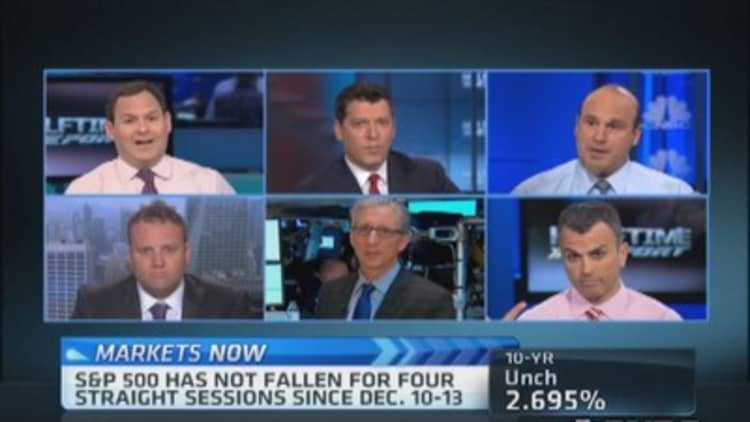
There's been a strange phenomenon going on I want to clear up: I've been hearing from my hedge-fund friends—particularly tech-oriented hedge funds—that there are considerable losses in the last two weeks, and yet the CBOE Volatility Index (VIX), which measures the relative levels of put and call buying in the near-term options, has barely budged, remaining at around 15, well below its long-term average.
Many have said that this is a sign there is no fear in the market.
I think this observation is inaccurate. There is fear, but it is not being expressed in the VIX.
The reason has to do with:
- The sea-change in the options business, and
- The rise of exchange-traded funds (ETFs).
Let's talk about the options business. In the last few years, you have been able to buy a whole variety of single-stock options and indexes, all of which expire at different times: Weekly, monthly and quarterly.
Traders have more choice than ever before, so just looking at a famous-but-old metric like options on the S&P 500 does not cut it anymore.
Then there's the rise of ETFs. Traders are turning to them because they are cheaper and easier to trade.
These two ideas—more choices in the form of options, and the rise of ETFs—are in practice often combined. For example, there's an ETF for the S&P tech sector: the XLK.
There are also options that are available for all the S&P sectors, including the XLK.
There is no published Volatility Index (VIX) for the XLK, but it can be calculated, and if it can be calculated, then someone will sell you puts and calls based on it.
You can thus either: 1) Short the XLK directly, or 2) buy put options on the XLK.
What do we see? Put buying has been very active in recent days in the XLK.
See? That doesn't show up in the VIX.
So, what's the best strategy if you are exposed here and want to protect yourself? That gets complicated.
The problem with shorting the XLK is if it rebounds, you can have losses. But if you just buy put options, you are protected on the downside, but you still have upside exposure.
This, of course, is the reason for owning options to begin with. It's an argument the options guys make all the time. You have to decide.
There's a broader problem here: Getting the kind of protection you want. The problem with shorting the XLK is that it is heavily weighted toward large-cap names like IBM.
There are more specific ETFs in the Internet space, like the First Trust Dow Jones Internet Index Funds (FDN), but my experience is that these types of very specific ETFs may be fairly thinly traded and difficult to borrow.
So if you want to short the internet names, you would likely go directly to shorting the individual names themselves.
The same is true with the major biotech ETF, the iShares Biotech ETF (IBB). You can buy options on this, and short it as well.
But be careful: It's very important to have a sense of when a reversal (of a selloff or a rally) may be about to start. It's also important to look at how many people are out shorting, because that represents shares that have to be bought back.
You don't believe me? Look at what is happening with the iShares Emerging Market ETF (EEM). The play at the start of the year was, short Emerging Markets.
And they did. But that has now become a very crowded short. Even as late as March 14 (the last date we have information for) the EEM was the second-heaviest short security by shares at the NYSE, after the SPDR S&P 500 (SPY). This represented only three days to cover, not a large amount, but this ETF has been heavily shorted since January.
What happens when you get a crowded short? Any time you get the slightest bit of positive news, it rockets up. Once word started leaking out that China might be more active with stimulus programs, the EEM began moving up—fast. It's been up 15 of the last 18 days.
Now, THAT is short covering.
Remember that when you rush to short the IBB or the XLK.
This all make perfect sense: Buying puts on the S&P 500 does not protect against you against crowded positions in overbought names like biotech and Internet.
Instead, traders are reaching for protection in areas they actually have exposure.
It's not that the VIX is broken. It's that there are more ways to buy protection in specific areas of the market than there were even a few years ago, and traders are using those alternative methods. That's a good thing, because 15 years ago about all they could do was buy puts on the S&P 500.
My final point: What WOULD move the VIX notably? The VIX would move if there was a big sea-change in the market...if the S&P 500 suddenly dropped 5 percent in a few days, for example.
But because the broader market has been relatively stable, the VIX has been stable.


